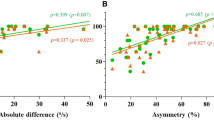Abstract
To investigate whether reported vertigo during the Epley maneuver predicts therapeutic success in patients with benign paroxysmal positioning vertigo of the posterior semicircular canal (pc-BPPV). Fifty consecutive adult patients with pc-BPPV, based on a positive Dix–Hallpike test (DHT), were treated with the Epley maneuver and retested after 2 days. Patients were asked to report the presence of vertigo upon assuming each of the four positions of the maneuver. Thirty seven patients (74 %) were treated successfully in one session. Twenty out of 23 patients who reported vertigo at turning the head to the opposite side (2nd position) had a negative DHT on follow-up. These patients had a higher chance of a successful outcome compared to patients who did not report vertigo in the 2nd position (Odds ratio 5.3, 95 % CI: 1.3–22.2, p = 0.022). Report of vertigo at the other positions was not associated with the outcome. Report of vertigo at the second position of a single modified Epley maneuver is associated with therapeutic success.
Similar content being viewed by others
References
Schuknecht HF (1969) Cupulolithiasis. Arch Otolaryngol 90:765–778
Hall SF, Ruby RR, McClure JA (1979) The mechanics of benign paroxysmal vertigo. J Otolaryngol 8:151–158
Epley JM (1992) The canalith repositioning procedure: for treatment of benign paroxysmal positional vertigo. Otolaryngol Head Neck Surg 107:399–404
Hilton M, Pinder D (2004) The Epley (canalith repositioning) manoeuvre for benign paroxysmal positional vertigo. Cochrane Database Syst Rev (2):CD003162
Semont A, Freyss G, Vitte E (1988) Curing the BPPV with a liberatory maneuver. Adv Otorhinolaryngol 42:290–293
Brandt T (1999) Vertigo: its multisensory syndromes, 2nd edn. Springer, Berlin
Parnes LS, Price-Jones RG (1993) Particle repositioning maneuver for benign paroxysmal positional vertigo. Ann Otol Rhinol Laryngol 102:325–331
Lopez-Escamez J, Gonzalez-Sanchez M, Salinero J (1999) Meta-analysis of the treatment of benign paroxysmal positional vertigo by Epley and Semont maneuvers. Acta Otorrinolaringol Esp 50:366–370
Levrat E, van Melle G, Monnier P, Maire R (2003) Efficacy of the Semont maneuver in benign paroxysmal positional vertigo. Arch Otolaryngol Head Neck Surg 129:629–633
Moreno NS, Andre AP (2009) Number of maneuvers need to get a negative Dix-Hallpike test. Braz J Otorhinolaryngol 75:650–653
Ahn SK, Jeon SY, Kim JP, Park JJ, Hur DG, Kim DW, Woo SH, Kwon OJ, Kim JY (2011) Clinical characteristics and treatment of benign paroxysmal positional vertigo after traumatic brain injury. J Trauma 70:442–446
Brandt T, Steddin S, Daroff RB (1994) Therapy for benign paroxysmal positioning vertigo, revisited. Neurology 44:796–800
Soto Varela A, Bartual Magro J, Santos Perez S, Velez Regueiro M, Lechuga Garcia R, Perez-Carro Rios A, Caballero L (2001) Benign paroxysmal vertigo: a comparative prospective study of the efficacy of Brandt and Daroff exercises, Semont and Epley maneuver. Rev Laryngol Otol Rhinol (Bord) 122:179–183
Soto-Varela A, Rossi-Izquierdo M, Santos-Perez S (2011) Can we predict the efficacy of the semont maneuver in the treatment of benign paroxysmal positional vertigo of the posterior semicircular canal? Otol Neurotol 32:1008–1011
Fyrmpas G, Rachovitsas D, Haidich AB, Constantinidis J, Triaridis S, Vital V, Tsalighopoulos M (2009) Are postural restrictions after an Epley maneuver unnecessary? First results of a controlled study and review of the literature. Auris Nasus Larynx 36:637–643
Hain TC, Squires TM, Stone HA (2005) Clinical implications of a mathematical model of benign paroxysmal positional vertigo. Ann NY Acad Sci 1039:384–394
Rajguru SM, Ifediba MA, Rabbitt RD (2004) Three-dimensional biomechanical model of benign paroxysmal positional vertigo. Ann Biomed Eng 32:831–846
Obrist D, Hegemann S (2008) Fluid-particle dynamics in canalithiasis. J R Soc Interface 5:1215–1229
Rajguru SM, Rabbitt RD (2007) Afferent responses during experimentally induced semicircular canalithiasis. J Neurophysiol 97:2355–2363
House MG, Honrubia V (2003) Theoretical models for the mechanisms of benign paroxysmal positional vertigo. Audiol Neurootol 8:91–99
Brandt T, Steddin S (1993) Current view of the mechanism of benign paroxysmal positioning vertigo: cupulolithiasis or canalolithiasis? J Vestib Res 3:373–382
White J, Savvides P, Cherian N, Oas J (2005) Canalith repositioning for benign paroxysmal positional vertigo. Otol Neurotol 26:704–710
Oh HJ, Kim JS, Han BI, Lim JG (2007) Predicting a successful treatment in posterior canal benign paroxysmal positional vertigo. Neurology 68:1219–1222
Zucca G, Valli S, Valli P, Perin P, Mira E (1998) Why do benign paroxysmal positional vertigo episodes recover spontaneously? J Vestib Res 8:325–329
Horii A, Kitahara T, Osaki Y, Imai T, Fukuda K, Sakagami M, Inohara H (2010) Intractable benign paroxysmal positioning vertigo: long-term follow-up and inner ear abnormality detected by three-dimensional magnetic resonance imaging. Otol Neurotol 31:250–255
Squires TM, Weidman MS, Hain TC (2004) Stone HA.A mathematical model for top-shelf vertigo: the role of sedimenting otoconia in BPPV. J Biomech 37:1137–1146
Faldon ME, Bronstein AM (2008) Head accelerations during particle repositioning manoeuvres. Audiol Neurootol 13:345–356
Furuya M, Suzuki M, Sato H (2003) Experimental study of speed-dependent positional nystagmus in benign paroxysmal positional vertigo. Acta Otolaryngol 123:709–712
Furman JM, Hain TC, Paige GD (1989) Central adaptation models of the vestibulo-ocular and optokinetic systems. Biol Cybern 61:255–264
Devaiah AK, Andreoli S (2010) Postmaneuver restrictions in benign paroxysmal positional vertigo: an individual patient data meta-analysis. Otolaryngol Head Neck Surg 142:155–159
Faralli M, Manzari L, Panichi R, Botti F, Ricci G, Longari F, Pettorossi VE (2011) Subjective visual vertical before and after treatment of a BPPV episode. Auris Nasus Larynx 38:307–311
Toupet M, Ferrary E, Grayeli AB (2011) Visual analog scale to assess vertigo and dizziness after repositioning maneuvers for benign paroxysmal positional vertigo. J Vestib Res 21:235–241
Author information
Authors and Affiliations
Corresponding author
Rights and permissions
About this article
Cite this article
Fyrmpas, G., Barkoulas, E., Haidich, A.B. et al. Vertigo during the Epley maneuver and success rate in patients with BPPV. Eur Arch Otorhinolaryngol 270, 2621–2625 (2013). https://doi.org/10.1007/s00405-012-2292-0
Received:
Accepted:
Published:
Issue Date:
DOI: https://doi.org/10.1007/s00405-012-2292-0



